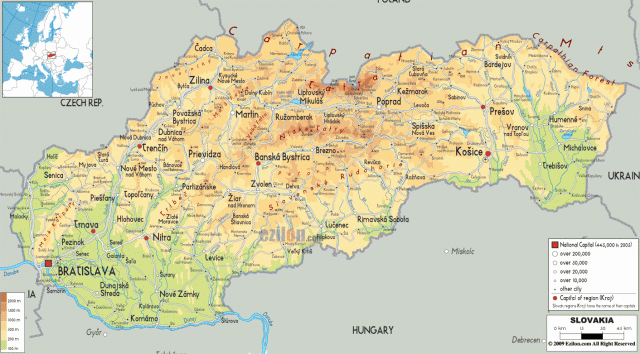Slovakia
Area 18,859 square mi (48,845 square km)
Population 5.419 million 2014
Capital Bratislava
Highest Point 8,682 ft (2,655 m)
Lowest Point 308 ft (94 m)
GDP $100.2 billion 2014
Primary Natural Resources brown coal, lignite, iron ore.
THE SLOVAK REPUBLIC or Slovakia is one of Europe's landlocked countries. Most of the country is rugged and mountainous, although the Tatra Mountains in the north are interspersed with many scenic lakes and valleys. The CZECH REPUBLIC and POLAND border the country to the north, with AUSTRIA to the west, HUNGARY to the south and the UKRAINE to the east.

The topography of Slovakia is dominated by the western Carpathian Mountains, a system of three eastwest-trending ranges (Outer, Central, and Inner) that are separated by valleys and intermontane basins. There are also two large lowland areas, the Little Alfold in the southwest and the Eastern Slovakian Lowland in the east that make up the Slovakian portion of the Inner Carpathian Depressions region. The Central range across the middle of Slovakia includes the country's highest mountains, the High Tatra Mountains, and the Low Tatra Mountains to the south, with elevations of about 6,500 feet (1,980 m). Farther to the south still, the Inner range extends into Hungary and contains the economically important Slovak Ore Mountains. The Little Alfold in the southwest is a fertile plain whose soil is drained by the Danube River and its tributaries, notably the Vah.
Slovakia's easterly position gives it a more continental climate than that of the Czech Republic to the west. It also has a much more mountainous terrain that lends itself to greater variation in climate and weather. Annual precipitation ranges from 22 in (57 cm) in the Danube plains to more than 43 in (110 cm) in windward mountain valleys. The higher peaks maintain snow cover into the summer months. Despite being landlocked, there is adequate access to the sea. Both Bratislava, the capital, and Komarno are major Danubian ports.
The Slovak leader Milan Rastilsav Stefanik joined the Czech leaders Thomas Masaryk and Eduard Benes in the creation of Czechoslovakia after World War I. However, in the postwar years, the Slovaks found themselves politically subordinate to the Czechs and benefited less from the economic prosperity of the interwar period. The Munich Agreement in 1938 sealed the fate of Czechoslovakia, as the Nazis dismembered the Czech regions and established a Slovakian puppet state by 1939. In 1948, after liberation from Nazi rule, Czechoslovakia fell under communist rule. In 1968, Slovaks joined Czechs in the Prague Spring, which called for reforms, only to be crushed by the Soviet Union. The Velvet Revolution in 1989, however, led Slovaks to assert themselves once again. The transition from a command economy directed by Moscow to a free market economy was more difficult for Slovaks than for the Czechs. Slovaks also wanted a greater say in foreign policy and other political issues.
By 1993, irreconcilable differences led to the separation of Slovakia as an independent country. Meciar became the prime minister of the new Slovak state. His authoritarian style of leadership caused some to doubt the course of a democratic Slovakia. Since independence, there have been friendly relations between the Czech Republic and Slovakia. res to join the North Atlantic Treaty Organization and the European Union. Slovaks make up the majority of the population in Slovakia. There is a significant Hungarian minority. In the postindependence period, there have been conflicts over recognizing the cultural rights of Hungarians living in Slovakia.